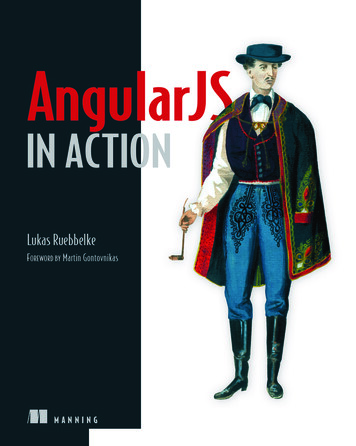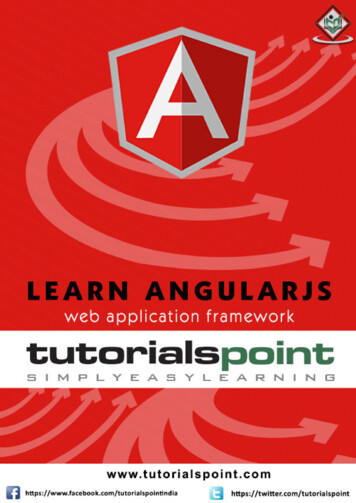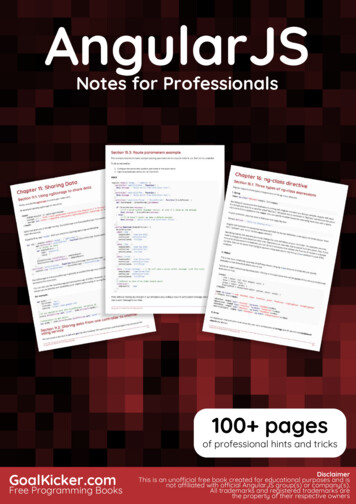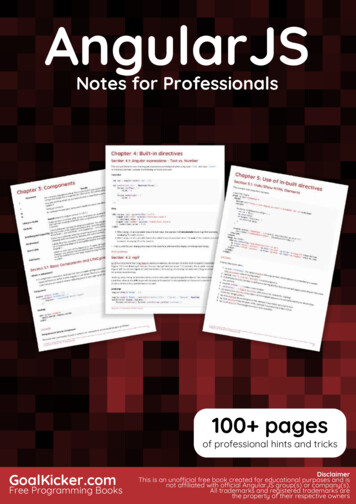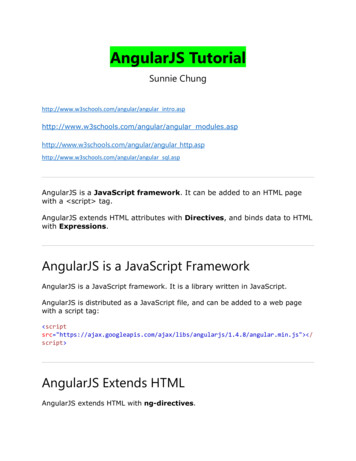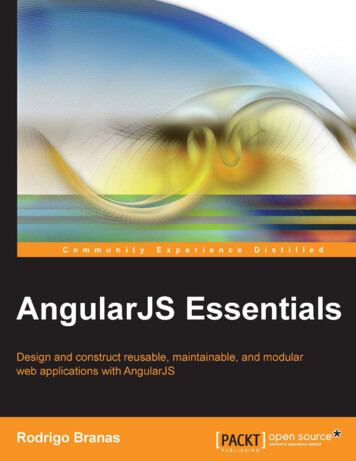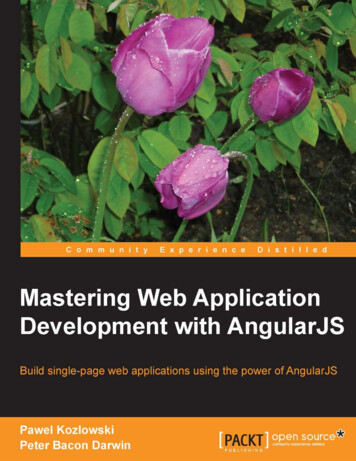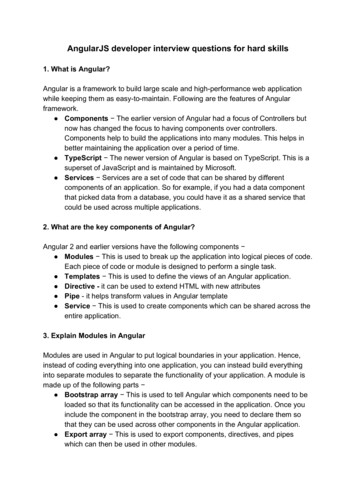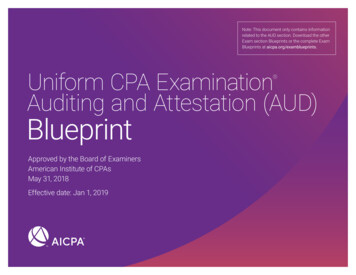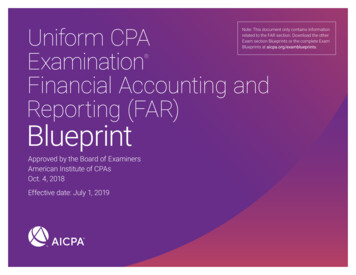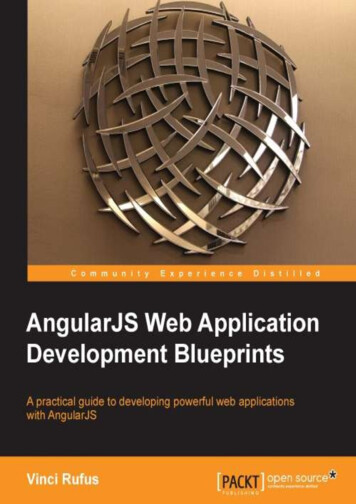
Transcription
AngularJS Web Application DevelopmentBlueprints
Table of ContentsAngularJS Web Application Development BlueprintsCreditsAbout the AuthorAbout the Reviewerswww.PacktPub.comSupport files, eBooks, discount offers, and moreWhy subscribe?Free access for Packt account holdersPrefaceAbout JavaScript MVC frameworksHow AngularJS was bornThe idea behind this bookWhat this book coversWhat you need for this bookSoftware versionsCopying the code filesWho this book is forConventionsReader feedbackCustomer supportDownloading the example codeErrataPiracyQuestions1. Introduction to AngularJS and the Single Page ApplicationDelving into Single Page AppsAnatomy of a simple AngularJS appModels and viewsBuilding an Address Book App
Understanding the scope in AngularJSStyling the appSorting the contacts alphabeticallyAdding contacts to the Address BookThe ng-show and ng-hide directivesSummary2. Setting Up Your RigSetting up Node.jsCreating a simple Node.js web server with ExpressJSSetting up GruntInstalling Grunt-cliCreating the package.json fileCreating your Grunt tasksGrunt tasks to merge and concatenate filesRunning shell commands via GruntYeoman – the workflow toolInstalling YeomanRunning your appUnit testing with KarmaUsing Protractor for End-to-End testsInstalling Selenium ServerUnderstanding the example spec.js fileUnderstanding the conf.js fileWriting your own Protractor test casesSummary3. Rapid Prototyping with AngularJSUnderstanding the application that we will PrototypeIntroducing Grid Layouts and BootstrapUnderstanding the grid systemIntroducing Angular UIUI-Utils
UI-ModulesUI-BootstrapNG-GridUI-RouterIDE PluginsPrototyping the Healthy Living websiteAdding the ui.bootstrap dependencyCreating the navigation barAdding the carouselTweaking the hero unitAdding the three content blocksCreating a new viewUnderstanding routesBuilding the articles viewAccordions using Angular BootstrapBuilding the image galleryGallery view using Bootstrap ThumbnailAdding the star ratingBuilding data grids using NG-GridAdding the NG-Grid componentGrouping data in NG-GridExcel-style editing in NG-GridCreating a modal window to add subscribersReal-time form validationsSummary4. Using REST Web Services in Your AngularJS AppUnderstanding the response from a REST APITesting a RESTful web serviceJump starting your app development with Angular SeedFiles and folders in Angular SeedAdding Bootstrap libraries
Starting your Node web serverMark-up our LayoutCreating the routesUnderstanding AngularJS servicesWriting your first factory serviceDependency InjectionCoding the partialCalling the REST web service using httpUsing promise for asynchronous callsDisplaying data from the JSON responseUnit testing our applicationMocking http during Unit testingCreating a Pinterest style layoutAdding actions to the buttonsSummary5. Facebook Friends’ Birthday Reminder AppUnderstanding the Facebook SDKThe Social GraphThe Graph APIThe Graph API ExplorerCreating your Facebook appSetting up our projectRunning your applicationDelving into AngularJS directivesWhat is a directive?Importance of naming conventions for directivesThe anatomy of a directiveWriting our first directiveAdding a Facebook loginAdding the fb-root div elementLoading the Facebook SDK
Understanding watch and digestWhen to use applyGetting the user’s friend listGetting your friends’ profile pictures and birthdaysRequesting additional permission with FB.loginUnderstanding isolated scopeAdding some CSS stylesChanging the routesAdding in the logout linkWriting automated testsWriting Unit tests with KarmaWriting End-to-End tests using ProtractorSummary6. Building an Expense Manager Mobile AppUnderstanding HTML5 Web StoragelocalStoragesessionStorageBuilding the Expense Manager AppBuilding the Add Expense formWhat is rootScope?Understanding the .run blockCreating a value service to store CategoryListValidating the Add Expense formUsing localStorage to save dataBuilding a bar chart directive based on D3Summarizing the expenses by categoriesCreating our bar chart directiveMaking the app responsiveAdding the CSS media queryScaling the D3 chart based on window sizeAdding touch events
Enabling swipe gestures using ngTouchAdding page transitions using ngAnimateLoading the ngAnimate moduleAdding CSS3 transitionsMaking the app feel like a native appAdding touch iconsRunning the app in fullscreen modeAdding additional featuresSummary7. Building a CMS on the MEAN StackWhy the MEAN stack?Getting started with the MEAN stackSetting up MongoDBSetting up ExpressJS and MongooseJSBuilding the server-side appCreating the Mongoose schemasCreating CRUD routesAdding a new entry to the collectionUpdating a collectionDeleting a collection itemDisplaying a single recordSecuring your admin sectionUsing bcrypt to encrypt passwordsAdding a new admin userCreating the route for authenticating loginCreating the logout routeWriting the sessionCheck middlewareIntegrating AngularJS with an ExpressJS projectGenerating SEO-friendly URLs using HTML5 modeBuilding the admin section for CRUD operationsCreating the routes for the admin section
Building the factory servicesBuilding the controllers for the admin sectionSetting up the admin page layoutBuilding the listing view for the admin sectionSetting up authentication in AngularJSCreating our login pageBuilding a custom module for global notificationBuilding and initializing the message.flash moduleBuilding the message.flash factory serviceSetting up broadcastsBuilding the directive for the message.flash moduleSetting a flash messageCreating our Add-Edit page controllerCreating our Add-Edit viewWriting a custom filter to autogenerate the URL fieldAdding the WYSIWYG editorSetting up an Interceptor to detect responsesBuilding the frontend of our CMSBuilding our navigation bar directiveBuilding the admin-login directiveDisplaying the content of a pageSetting the default home pageSummary8. Scalable Architecture for Deployments on AWSUnderstanding the various services in Amazon AWSDelving into AWS deployment architecturesThe EC2 server-based architectureThe Server-less ArchitectureDeploying our app in a Server-less Architecture on AWSMapping a domain to S3Mapping the S3 bucket to a CloudFront distribution
Getting your app ready for production deploymentImproving the page-load time of your appSetting Expires headersPerformanceSummary9. Building an E-Commerce StoreBackend as a ServiceBuilding a BaaS platform on AWSSetting up an S3 Bucket with public read accessSetting up the CORS policy on your S3 bucketCreating our DynamoDB tablesCreating the Identity and Access Management (IAM) roleCreating our e-commerce appBuilding nested views using UI-RouterMapping states to URL, views, and controllersPrototyping our applicationSetting up our index.html fileCreating the controllersCreating the product partialsAdding animations to the view transitionsAdding in the CSS transition effectsCreating our application-level controllerAdding a Facebook loginIntegrating AWS JS SDK with our applicationCreating the AWS service providerBuilding our Add Products pageSaving data in DynamoDB tablesCreating the view for the add product formBuilding the controller for the add products viewUploading images to S3Fetching the products lists for a category
Using resolves to preload dataCreating our product details pageAdding products to cartThe checkout pageSaving the ordersSummaryA. AngularJS ResourcesOfficial resourcesRecommended AngularJS modulesBoiler platesLearning resourcesGood friends with AngularJS (third-party tools and services)Core team members and knowledgeable people to followIndex
AngularJS Web Application DevelopmentBlueprints
AngularJS Web Application DevelopmentBlueprintsCopyright 2014 Packt PublishingAll rights reserved. No part of this book may be reproduced, stored in a retrieval system,or transmitted in any form or by any means, without the prior written permission of thepublisher, except in the case of brief quotations embedded in critical articles or reviews.Every effort has been made in the preparation of this book to ensure the accuracy of theinformation presented. However, the information contained in this book is sold withoutwarranty, either express or implied. Neither the author, nor Packt Publishing, and itsdealers and distributors will be held liable for any damages caused or alleged to be causeddirectly or indirectly by this book.Packt Publishing has endeavored to provide trademark information about all of thecompanies and products mentioned in this book by the appropriate use of capitals.However, Packt Publishing cannot guarantee the accuracy of this information.First published: August 2014Production reference: 1180814Published by Packt Publishing Ltd.Livery Place35 Livery StreetBirmingham B3 2PB, UK.ISBN 978-1-78328-561-7www.packtpub.comCover image by Faiz Fattohi ( faizfattohi@gmail.com )
CreditsAuthorVinci RufusReviewersJeff CunninghamAshutosh DasAJ KerriganCiro NunesYacine RezguiCommissioning EditorAkram HussainAcquisition EditorRichard HarveyContent Development EditorVaibhav PawarTechnical EditorsShashank DesaiMenza MathewCopy EditorsKaruna NarayananAlfida PaivaLaxmi SubramanianProject CoordinatorsBinny K. BabuKranti BerdeProofreadersBridget BraundPaul HindleLucy RowlandIndexersHemangini Bari
Mariammal ChettiyarRekha NairPriya SubramaniGraphicsValentina D’silvaProduction CoordinatorAparna BhagatCover WorkAparna Bhagat
About the AuthorVinci Rufus has been working with frontend technologies for close to 14 years now. Hestarted his career building games with Flash ActionScript and later moved on to JavaScriptand HTML5. During his spare time, he enjoys conducting workshops and training people.For a living, he mentors, guides, and helps grow the technology team at Razorfish Neev,primarily in the area of commerce, usability, and emerging technologies.A sincere thanks to the awesome team at Razorfish Neev. I’ve learned so much workingwith you all.My deepest regards to the technical reviewers, Jeff Cunningham, Ashutosh Das, AJKerrigan, Ciro Nunes, and Yacine Rezgui, and also to the content development editor,Vaibhav Pawar, whose insights and feedback greatly helped in adding the finishingtouches for this book.A big thank you to my family; my dad, Rufus, who learned computers only so that hecould teach me; my mom, Anne, who has always encouraged me to take up challengesevery time I thought it wasn’t possible; my awesome kids, Shannon and Jaden, whosacrificed a lot of their play time so that I could write this book; my wife, Raina, for all thesupport that was instrumental in this book reaching its completion; and finally, my sister,Blaisy, who was always there to give feedback and critique my work, and with whom Icould brainstorm and discuss ideas.
About the ReviewersJeff Cunningham is a mobile app developer at Comdata in Nashville, TN. After 15 yearsof working in the field of Java web development, he now enjoys the challenges offrontend and mobile development. He also reviewed the book, AngularJS Directives,Packt Publishing, and maintains the popular repo named AngularJS-Learning on earning).Ashutosh Das, who hails from Bangladesh, works mainly as a backend developer and hisexperience includes working with Django, Node.js, Laravel, and so on. He also likes towork with AngularJS. He spends his spare time writing for GitHub. He also works as afreelancer and is a part-time job holder. He is currently in the process of reviewing thebook, AngularJS UI Development, Packt Publishing.AJ Kerrigan is a systems analyst with a small IT department in New Jersey. His technicalduties and interests include server and database administration, command-line scripting,and web development.AngularJS Web Application Development Blueprints, Packt Publishing, represents AJ’sfirst experience as a technical reviewer.I would like to thank my wife, daughter, and dog for their love, support, and endlesssupply of hugs. Thanks to my father as well, who provided me with my first exposure toprogramming (BASIC on the family TI-99/4a computer). He has been a consistent sourceof encouragement and guidance.Ciro Nunes is a 22-year old frontend engineer, test-first evangelist, and specialist in largescale architectures for heavy client-side applications. At such a young age, he has beenresponsible for the development of the biggest e-commerce websites from Latin America.He’s also the organizer of the AngularJS SP Meetup which has more than 400 members.Nowadays, he’s working on applications for the financial market that pushes theboundaries of AngularJS.I want to thank my family and friends for their patience, with me being so absent lately. Ipromise that I’m going to walk more with the dog and spend more time with you whom Ilove.Yacine Rezgui is a French-Tunisian web developer. He started web developing at the ageof 12, and since then, has made his passion his job. He’s specialized in web developmentand strongly believes that it is the best cross-platform environment. He’s currently theorganizer of the London Phonegap Meetup.He worked in different companies such as Médiamétrie eStat, Tequila Rapido, andGovernorHub as a freelancer.I would like to thank my friends, James Nocentini, James Sharp, Cédric Ferretti, andXavier Kress for supporting me on my work, my family for all their encouragement, andXuxu for helping me to focus.
www.PacktPub.com
Support files, eBooks, discount offers, andmoreYou might want to visit www.PacktPub.com for support files and downloads related toyour book.Did you know that Packt offers eBook versions of every book published, with PDF andePub files available? You can upgrade to the eBook version at www.PacktPub.com and asa print book customer, you are entitled to a discount on the eBook copy. Get in touch withus at service@packtpub.com for more details.At www.PacktPub.com, you can also read a collection of free technical articles, sign upfor a range of free newsletters and receive exclusive discounts and offers on Packt booksand eBooks.http://PacktLib.PacktPub.comDo you need instant solutions to your IT questions? PacktLib is Packt’s online digitalbook library. Here, you can access, read and search across Packt’s entire library of books.
Why subscribe?Fully searchable across every book published by PacktCopy and paste, print and bookmark contentOn demand and accessible via web browser
Free access for Packt account holdersIf you have an account with Packt at www.PacktPub.com, you can use this to accessPacktLib today and view nine entirely free books. Simply use your login credentials forimmediate access.
PrefaceThe most annoying part of using any website or web application is the time we wait forpages to load. Sure, everybody is working on making the Web fast, but those 2-3 secondsthat it takes for a round trip to the server does not stop you from opening multiple tabs andoften forgetting which tab you originally were on.The rapid popularity of JavaScript frameworks and technologies such as AJAX clearlyshow the desperate need to save those 1 or 2, second-round trips to the server, and providethe users with a more desktop-like user experience.
About JavaScript MVC frameworksThese JavaScript frameworks aren’t some new revolutionary technology or a newdiscovery; they are all still using the same old faithful JavaScript. These JavaScriptframeworks merely provide a layer of abstraction (if I may) or a more Model-ViewController-like architecture, so that we can be more productive while building apps anddon’t really have to worry about mundane things.The credit for the rising popularity of these JavaScript frameworks would go to this surgeof JavaScript-based highly interactive and rich Internet applications that nowadays do somuch more than just displaying data received from a backend server. All of this is possiblethanks to the modern day browser and their JavaScript engines that have become fasterand powerful.There has nearly been an explosion of these JavaScript MVC frameworks, and every otherday, we see a new framework being launched. While most people consider Backbone.js orSproutCore to be one of the first JavaScript frameworks, I would say Ext JS by Sencha hasbeen among the first JavaScript frameworks and one that is still being extensively used inthe corporate world mainly to build finance apps. While Backbone.js and SproutCore werelaunched in 2010, Version 2.0 of Ext JS was launched towards the end of 2007.AngularJS too was launched somewhere in 2010. Around the same time, other JavaScriptframeworks were sprouting up. However, it is probably the fastest growing framework interms of user adoption, mainly due to the “wow” factor and also the backing from the bigG.Each framework has its own pros and cons, and ideally the choice of the framework woulddepend on the nature of your project.Notehttp://www.todomvc.com/ is a very nice site to understand and compare the functioning ofthese JavaScript frameworks.AngularJS is currently the most popular JavaScript MVC framework. Some of the reasonsfor this would be as follows:It’s among the simplest to learnIt follows some of the best software-engineering concepts, and is ideal to build large,scalable appsIt has a robust testing framework to run Unit tests and End-to-End tests, thus makingit easy to write and run automated test casesIt also allows for teams to work in parallel on a single application without steppingover each other’s workIt has the fastest growing community of adaptors, and the AngularJS Google Groupsand IRC chats are a great place to interact with others
How AngularJS was bornAngularJS started as an internal Google project by Misko Hevery, sometime in 2009. Asthe story goes, Misko’s team was working on a project called Google Feedback; even aftersix months of development and about 17,000 lines of code, they were still unhappy withthe pace of development and the inability to write automated tests. That’s when Miskodecided to rewrite that. It took him about 3 weeks and he managed to write the wholething in just about 1,500 lines of code.That’s when AngularJS got some serious attention internally at Google, and a team wasput together to help further develop it. Around 2010, Google decided to declare it as opensource under the MIT license.
The idea behind this bookThe idea behind writing this book is to showcase the different types of applications thatcan be built on AngularJS. Besides explaining AngularJS and how to write modular andtestable code, there is a fair amount of emphasis on making those apps look beautiful. So,be ready for some CSS stuff and design-related discussions.I’ve tried to cover a variety of applications ranging from a simple address book, anHTML5 mobile app, an e-commerce store, a CMS framework, and also ideas on how todeploy apps on Amazon AWS.
What this book coversThis book is broken down into nine chapters.Chapter 1, Introduction to AngularJS and the Single Page Application, talks about theconcept of a Single Page App and how they are different from the regular web apps. We’llalso learn about the basics of AngularJS by building a simple Address Book App.Chapter 2, Setting Up Your Rig, talks about how having the right set of tools can be a hugeproductivity booster. It also makes you feel like a pro when building your AngularJS app.This chapter will talk about some of the tools such as Node.js, ExpressJS, Grunt, Yeoman,and Karma.Chapter 3, Rapid Prototyping with AngularJS, talks about the ease with which one cancreate clickable prototypes to get a feel of how an application would look and feel beforeworking on any backend code.Chapter 4, Using REST Web Services in Your AngularJS App, will show you how toconsume data from third-party REST web services using factories and the http service.Chapter 5, Facebook Friends’ Birthday Reminder App, will explain directives and how wecan create our Facebook login directive. We will also set up some automated tests toensure everything is working fine.Chapter 6, Building an Expense Manager Mobile App, will walk you through the processof building a responsive and touch-friendly mobile app using ngAnimate and HTML5features such as localStorage.Chapter 7, Building a CMS on the MEAN Stack, talks about how to set up an entirebackend and frontend system and how AngularJS interacts with a node server andMongoDB database. We will also look at session management and interceptors.Chapter 8, Scalable Architecture for Deployments on AWS, will teach you about AWS andits various services, and how we can deploy our app in a Server-less Architecture that caninherently scale.Chapter 9, Building an E-Commerce Store, will show you how to directly read and writedata from AWS’s DynamoDB database, and upload images to S3 directly from ourJavaScript app.Appendix, AngularJS Resources. Well, you know what to expect here.
What you need for this bookYou obviously don’t need to read the entire book before you can start working on yourfirst AngularJS project. I’m a firm believer of learning things the practical way, and that’swhy from the very first chapter, you will find yourself firing up your IDE/Text editor, andwriting code and testing it on your browser.While you will learn a couple of new features of AngularJS in each of the chapters, eachchapter is still self-contained, and you can comfortably jump to any of the chapters thatinterest you or that you need to refer to for your project.However, if you are just starting off with AngularJS, then I strongly recommend that youread through the first three chapters before you start jumping.
Software versionsThe current stable version of AngularJS while writing this book is 1.2, and unlessspecified, we will be using the stable version of 1.2.17 for all the examples in this book.You can get the latest version of AngularJS using any of the following methods:Download the compiled minified version from http://www.angularjs.org.Fork or clone the source code from the GitHub URLhttps://github.com/angular/angular.js.The recommended option for both development and production code is to call theAngularJS file directly from the Google CDN. The link to the AngularJS section onthe CDN is uide#angularjs.
Copying the code filesThe code examples mentioned in this book can be used in your programs. However, if youchoose to burn them on to CDs for redistribution or are putting up the code examples fordownloads, you are required to get explicit permission from Packt Publishing.
Who this book is forThis book is mainly aimed at professionals, both designers and programmers. Thankfully,AngularJS is evolving to be a framework where both designers and programmers worktogether without discriminating each other as backend developers or frontend designers.The book obviously assumes that you know your basics in HTML, CSS, and JavaScript.You understand the importance and need for writing modular, scalable, testable, and goodlooking applications. You don’t need to have worked with AngularJS or any otherJavaScript framework to understand the topics covered. The book assumes you just metAngularJS on a blind date.The book starts off with getting you comfortable with the basic concepts that you comeacross very often while working with AngularJS. We’ll write some simple code just to seehow AngularJS works, understanding it better, and then we’ll graduate to writing cleanerand modular code.Also, I have a chapter dedicated to setting up your development “rig” with a set of toolsand plugins that will help you boost your productivity while building AngularJS apps.
ConventionsIn this book, you will find a number of styles of text that distinguish between differentkinds of information. Here are some examples of these styles, and an explanation of theirmeaning.Code words in text, database table names, folder names, filenames, file extensions,pathnames, dummy URLs, user input, and Twitter handles are shown as follows: “Now,angular-bootstrap will be available for use across our application.”A block of code is set as follows: carousel interval "setInterval" slide ng-repeat "slide in slides" active "slide.active" /slide /carousel When we wish to draw your attention to a particular part of a code block, the relevantlines or items are set in bold: body ng-app ng-init " myName 'John Doe' " {{myName}} is {{ 2014-1968}} years old. script src " angular.min.js " type "text/javascript " /script /body Any command-line input or output is written as follows:yo angular:route subscribersNew terms and important words are shown in bold. Words that you see on the screen, inmenus or dialog boxes for example, appear in the text like this: “Click on the Downloadbutton and select the following options from the pop-up window:”NoteWarnings or important notes appear in a box like this.TipTips and tricks appear like this.
Reader feedbackFeedback from our readers is always welcome. Let us know what you think about thisbook—what you liked or may have disliked. Reader feedback is important for us todevelop titles that you really get the most out of.To send us general feedback, simply send an e-mail to feedback@packtpub.com , andmention the book title via the subject of your message.If there is a topic that you have expertise in and you are interested in either writing orcontributing to a book, see our author guide on www.packtpub.com/authors.
Customer supportNow that you are the proud owner of a Packt book, we have a number of things to helpyou to get the most from your purchase.
Downloading the example codeYou can download the example code files for all Packt books you have purchased fromyour account at http://www.packtpub.com. If you purchased this book elsewhere, you canvisit http://www.packtpub.com/support and register to have the files e-mailed directly toyou.
ErrataAlthough we have taken every care to ensure the accuracy of our content, mistakes dohappen. If you find a mistake in one of our books—maybe a mistake in the text or thecode—we would be grateful if you would report this to us. By doing so, you can saveother readers from frustration and help us improve subsequent versions of this book. Ifyou find any errata, please report them by visiting http://www.packtpub.com/submiterrata, selecting your book, clicking on the errata submission form link, and entering thedetails of your errata. Once your errata are verified, your submission will be accepted andthe errata will be uploaded on our website, or added to any list of existing errata, under theErrata section of that title. Any existing errata can be viewed by selecting your title fromhttp://www.packtpub.com/support.
PiracyPiracy of copyright material on the Internet is an ongoing problem across all media. AtPackt, we take the protection of our copyright and licenses very seriously. If you comeacross any illegal copies of our works, in any form, on the Internet, please provide us withthe location address or website name immediately so that we can pursue a remedy.Please contact us at copyright@packtpub.com with a link to the suspected piratedmaterial.We appreciate your help in protecting our authors, and our ability to bring you valuablecontent.
QuestionsYou can contact us at questions@packtpub.com if you are having a problem with anyaspect of the book, and we will do our best to address it.
Chapter 1. Introduction to AngularJS andthe Single Page ApplicationIn this chapter, we’ll learn what Single Page Apps are and how they differ from the regularweb applications. We will also learn the fundamentals of AngularJS and go about buildinga simple Address Book App using it.The list of topics to be covered in the chapter are as follows:What are Single Page Apps?Anatomy of an appModels and viewsBuilding an Address Book AppStyling the app with CSSAdding items to the Address Book
Delving into Single Page AppsBesides other things, AngularJS is primarily used to build Single Page Apps (SPAs), solet us first understand its characteristics.Single Page Apps are apps or websites wherein the entire site or app content loads withina single page. This essentially means that once the app or website is loaded in the browser,clicking on any link would not reload the entire page but would simply update certainsections within the main page itself. This gives users a very desktop-like feel while usingan SPA.Although SPAs have become very popular nowadays, the concept has been discussed asearly as 2003, and the term Single Page App was coined in 2005.Some of the technologies that play a predominant role in building SPAs are HTML, CSS,JavaScript, AJAX, and web services usually RESTful. Of these, JavaScript plays the mostcrucial role in building an SPA, so if you have been procrastinating on sharpening yourJavaScript skills this would be the best time to get up and get started.One of the fundamental differences in the way SPAs work against regular websites is theway the pages are built, which the user sees. Refer to the following diagram:
In traditional web applications that are built on the server-side technologies such as Java,PHP, and .NET, whenever a page is requested, the web server would make a request to thedatabase, fetch the result of the query, then load the template, and dynamically generatethe final page, which is sent down to the browser. As you can see here, the web server isdoing all the heavy lifting, and as the traffic to the server increases, the web serverbecomes a bottleneck. This is why popular high-traffic sites need a lot of servers.Single Page Apps, especially those built on JavaScript frameworks such as AngularJSwork in a slightly different fashion. Refer to the following diagram:In an SPA architecture, the entire template along with the HTML, JavaScript, and CSS isdownloaded to the user’s browser, so when a request
book, AngularJS UI Development, Packt Publishing. AJ Kerrigan is a systems analyst with a small IT department in New Jersey. His technical duties and interests include server and database administration, command-line scripting, and web development. AngularJS Web Application
